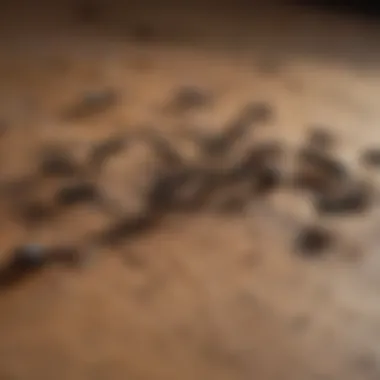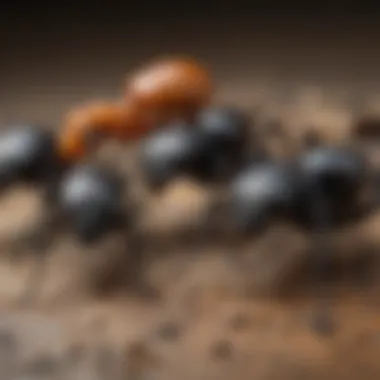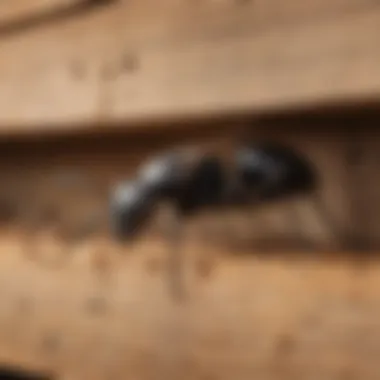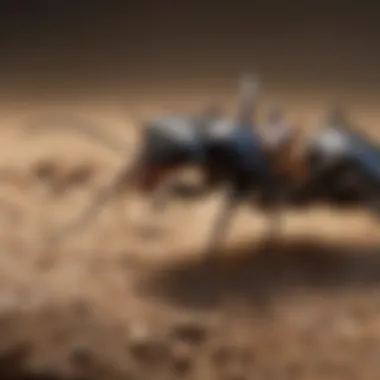Understanding Carpenter Ant Droppings: Identification, Implications, and Management Strategies


Intro
Carpenter ants are a common concern for homeowners. Their presence often signifies potential damage to wooden structures. Understanding their droppings, known as frass, is crucial for effective pest management. Identifying these droppings can be the first step in addressing an infestation.
In this article, we will explore how to recognize carpenter ant droppings, discuss the implications of an infestation, and outline practical management strategies. This information is particularly relevant for housewives and homeowners who want to protect their properties from pest-related damage.
Pest Identification
Identifying carpenter ants is essential to taking control of a pest situation. Common characteristics include a black or bicolored appearance. They typically measure between 1/4 to 1/2 inch long. However, it is their droppings that provide clear evidence of their presence.
Detailed Descriptions of Common Pests
Carpenter ants can be mistaken for other ant species. They differ from termites and other wood-damaging insects. Their colonies may contain thousands of ants. They prefer moist wood, making areas like basements and crawl spaces prime targets for infestation.
Signs and Symptoms of Infestations
- Frass: As mentioned, frass is the key sign. It resembles small dark pellets or wood shavings. This substance is not just waste; it can indicate the location of an active nest.
- Hollow Sound: Tapping on wood can reveal hollow sounds if carpenter ants are present. This means they may be burrowing channels inside.
- Foraging Behavior: Spotting ants wandering in and out of your home is a clear signal of an infestation.
"Frass is not merely waste; it is a clear indicator of carpenter ant activity and the need for immediate action."
Prevention Strategies
Preventing carpenter ant infestations requires vigilance and maintenance. Here are some tips:
Home Maintenance Tips for Pest Prevention
- Seal Cracks and Gaps: Inspect your home regularly for openings where ants can enter.
- Moisture Control: Fix leaks and ensure proper drainage around your home. Carpenter ants thrive in damp environments.
- Trim Vegetation: Keep trees and shrubs trimmed back to reduce contact with your home.
Natural Deterrents and Barriers
Several natural options can deter carpenter ants:
- Essential Oils: Sprays made from peppermint or tea tree oil can create a barrier.
- Diatomaceous Earth: This powder can be dusted in areas where you suspect activity. It is safe for human use, yet harmful to insects.
Treatment Options
If prevention fails and an infestation occurs, various treatment options exist.
Overview of Chemical vs. Natural Treatments
Chemical treatments are effective but may pose risks. Natural treatments are safer but can take longer to work. Choosing the right method depends on the severity of the infestation and personal preferences.
Step-by-Step Guides for DIY Treatments
- Identify the Source: Locate the main nest by tracking the ants.
- Use Bait Traps: Set up commercial traps that contain slow-acting poison. The ants will carry it back to the nest, effectively eliminating the colony.
- Apply Natural Remedies: For a less invasive approach, use the natural deterrents mentioned earlier.
Prologue to Carpenter Ants
Carpenter ants are more than just a nuisance; they can cause significant damage to wooden structures if left unchecked. Understanding their behavior and habitat is essential for homeowners, as it allows for effective preventive measures and timely intervention. This section will outline key aspects of carpenter ant biology and behavior, as well as their distribution, giving readers a comprehensive overview of these pests. By grasping these concepts, one can better appreciate the implications of finding ant droppings in one's home, laying the groundwork for the management strategies that will be discussed later in the article.
Biology and Behavior of Carpenter Ants
Carpenter ants are large, social insects that exhibit fascinating behaviors. They belong to the family Formicidae and are known for their ability to excavate wood to create nests. Their body is typically black or bicolored, ranging from red and black. Carpenter ants can grow up to 1 inch long, making them easily identifiable among other ant species.
Carpenter ants are nocturnal creatures, often foraging at night. They don't consume wood directly. Instead, they chew it and transport the sawdust-like debris outside, which is known as frass. This behavior makes their presence detectable, serving as a crucial sign of infestation. They generally prefer moist and decayed wood, which makes their nests typically located indoors in areas like attics, basements, or behind walls and moldy beams.
These ants develop colonies that can range from several hundred to thousands. Within a colony, there are different roles, which include workers, soldiers, and reproductive ants. Worker ants perform the essential task of foraging for food, while soldier ants protect the nest from threats.
Distribution and Habitat Preferences


Carpenter ants are widely distributed across North America, inhabiting various climates from coastal areas to interior forests. They thrive in regions with ample wood resources and moisture. Their presence is notably higher in areas that have experienced recent rainfall or flooding, providing the humid environments they prefer for nesting.
Common habitats include:
- Forested areas: Here, they find plenty of suitable wood for nesting and foraging.
- Urban environments: Carpenter ants are often found in residential buildings, particularly those with structural wood damage or moisture issues.
- Near old trees or stumps: These locations offer decayed wood, ideal for colony establishment.
Understanding where carpenter ants typically dwell can help homeowners recognize potential issues in their own properties before infestations occur. Addressing moisture problems and maintaining wood structures can effectively deter these pests.
Understanding Carpenter Ant Droppings
Carpenter ant droppings, known as frass, are an integral part of identifying infestations within structures. These droppings provide insight into the activity level of these pests. Understanding carpenter ant droppings is crucial for effective management and prevention. Recognizing the signs of an infestation allows homeowners to take prompt actions, potentially preventing extensive damage. This section discusses critical aspects of frass and its implications for maintaining a healthy living environment.
Defining Frass: What You Need to Know
Frass is the term used to describe the droppings produced by carpenter ants during their activities. These droppings are composed mainly of wood particles, mixed with excretion. They typically appear as small, dark granules, often resembling pepper or sawdust. The presence of frass is a key indicator of carpenter ant activity in the area. When you encounter frass, it is essential to investigate further, as it may signify nesting nearby.
Key Points About Frass:
- Frass indicates ongoing wood damage caused by carpenter ants.
- It can also be mistaken for droppings from other pests, necessitating careful identification.
- Noticing frass should prompt homeowners to assess their property for potential infestations.
In summary, understanding frass is the first step in managing carpenter ant problems. Awareness of this component can lead to earlier interventions.
Composition of Carpenter Ant Droppings
Carpenter ant droppings consist primarily of fine wood shavings. This composition results from the ants excavating wood to create their nests. Along with wood particles, the droppings may include digested material from plant sources. The presence of cellulose in the droppings is significant, as ants consume wood for its nutrients, but they do not digest it fully.
The composition highlights important aspects of carpenter ant life and their behavior:
- Wood Shavings: These come from the wood they tunnel through. The size and texture can vary based on the wood type.
- Digested Material: The digested parts reflect the diet of the ants, which includes various plant materials.
- Moisture Content: Carpenter ant droppings often have moisture, indicating a live colony nearby.
The composition significantly contributes to confirming a carpenter ant infestation. Homeowners should closely examine any droppings for these characteristics. By understanding what constitutes carpenter ant droppings, one can better identify problems and take action accordingly.
"Immediate identification and understanding of frass not only facilitates pest control but also protects structural integrity."
Identifying Carpenter Ant Droppings
Identifying carpenter ant droppings is essential for homeowners and property managers. These droppings, known as frass, are a direct indicator of carpenter ant activity within a structure. Recognizing them can help in early detection of infestations, enabling timely management strategies to prevent more significant damage. This section will detail the methodical approach needed to effectively identify carpenter ant droppings, focusing on their physical characteristics, color, and texture, as well as comparisons with droppings from other pests.
Physical Characteristics
Carpenter ant droppings possess unique physical traits that set them apart from other pest droppings. Typically, frass appears as small, rounded pellets, often measuring about 1 to 2 mm in length. The texture is usually granular. These pellets may also have a rough feel, owing to the fact that carpenter ants chew through wood, mixing it with saliva and then expelling it. Recognizing these specific characteristics is crucial not only for identification but also for understanding the level of infestation present in your home.
Homeowners should pay close attention to the presence of frass in areas where wood contact is frequent, especially near structural wood, moisture-prone areas, and hollow voids where ants may be nesting. The incorrect identification can lead to ineffective pest control measures, prolonging the infestation and damage.
Color and Texture Analysis
The color and texture of carpenter ant droppings provide additional clues for identification. Generally, the color of frass ranges from brown to black, reflecting the wood and material the ants have consumed. The texture, as mentioned previously, is typically more coarse compared to droppings from other pests, which tend to be smoother and more uniform in appearance.
To accurately identify carpenter ant droppings:
- Examine the droppings under natural light if possible. The textures and color variations are often more apparent.
- Look at the droppings' surroundings; frass is usually found near wood damage, such as shavings or sawdust.
This analysis not only aids in identifying the species but also informs the severity of the infestation, allowing homeowners to implement appropriate measures.
Comparison with Droppings from Other Pests
When identifying carpenter ant droppings, it is also important to distinguish them from those produced by other pests. Many insects can create similar droppings, but a few key differences exist. For example, droppings from termites tend to be more aligned in shape and have a more powdery texture, given that they feed on cellulose. In contrast, mouse droppings are typically larger and more oval-shaped.
Key Point: Proper identification of frass is crucial for confirming the presence of carpenter ants. Incorrect assumptions may lead to inadequate pest management strategies.
When unsure about the type of droppings found, consider documenting the characteristics and location and seeking advice from pest control experts.


Understanding these distinctions not only facilitates a more precise identification but also enhances the effectiveness of subsequent management and treatment strategies. By having a clear grasp of what to look for, homeowners can act swiftly and effectively against carpenter ant infestations.
Implications of Finding Droppings
Understanding the implications of finding carpenter ant droppings is a vital part of managing these pests. The presence of carpenter ant droppings in your home is often the first sign of an infestation. Recognizing this evidence and acting on it promptly can save a home from significant damage. This section will explore the indicators of an infestation, the potential structural damage that can occur, and the health concerns that may arise from an unchecked infestation.
Signs of Infestation
When carpenter ants invade a property, they leave distinct signs of their presence. The droppings, known as frass, resemble wood shavings mixed with small droplet-like pellets. If you discover frass, it often indicates that carpenter ants are nesting close by. Other signs include:
- Hollowed-out wood: Carpenter ants excavate wood to create their nests, leaving behind hollowed wood structures.
- Rustling noises: During the night, you may hear soft rustling sounds in walls or ceilings, indicating that ants are active.
- Sightings of ants: Seeing worker carpenter ants, especially large black or red ones, signals an active nest.
These signs are crucial for homeowners to note as they help in early identification of ant activity.
Potential Structural Damage
Carpenter ants are notorious for causing damage to wooden structures. Unlike termites, they do not consume wood for sustenance; rather, they excavate it to create nests. Over time, this can lead to severe consequences, such as:
- Weakened supports: Beams, joists, and other structural supports can become compromised, posing a safety risk.
- Increased repair costs: Delayed detection can result in extensive damage, leading to higher repair expenses.
- Aesthetic issues: Damage can lead to unsightly openings in woodwork, affecting the overall appearance of your home.
It is essential to address these issues promptly to avoid escalating problems that could compromise the integrity of your house.
Health Concerns Related to Infestations
While carpenter ants do not pose direct health risks like other pests, their presence can lead to indirect health concerns. For instance:
- Allergens: Droppings can aggravate allergies or respiratory issues in sensitive individuals.
- Bacterial spread: Ants can carry bacteria from their environment, potentially contaminating food sources.
A proactive approach in managing carpenter ants is essential not only for preserving the structure of the home but also for maintaining a healthy living environment.
"Identifying carpenter ant droppings is crucial. They reveal the potential for damage and help you take targeted action."
In summary, recognizing the signs of carpenter ant infestations, understanding their potential for structural damage, and being aware of health concerns is vital for homeowners to protect their property and well-being.
Prevention Strategies
Preventing carpenter ant infestations is crucial for protecting your home and maintaining its structural integrity. By understanding the key strategies, homeowners can effectively mitigate the risk of these pests. The focus of prevention strategies is to eliminate attractants that lure carpenter ants and to make the environment less hospitable for them. This not only reduces the likelihood of an invasion but also fosters a healthier living space.
Identifying At-Risk Areas
The first step in prevention is identifying at-risk areas within your home. Carpenter ants look for moist, decaying wood to establish their nests. Therefore, focus on regions with high humidity or unexplained dampness. Common areas include:
- Basements: Check for any water leaks from plumbing or excessive condensation.
- Attics: Inspect for stagnant air or roof leaks that might lead to wet wood.
- Exterior: Look at areas where trees or shrubs touch the house, as these provide easy access for ants.
- Window and door frames: Pay attention to gaps or cracks where moisture can accumulate.
Being proactive in inspecting these areas can help in identifying problem regions before they become infested.
Moisture Control Techniques
Moisture control is pivotal in preventing carpenter ants. Implementing effective moisture control measures can significantly reduce the risk of infestation. Consider the following strategies:
- Fix leaks promptly: Regularly check for and repair leaking pipes and fixtures.
- Improve drainage: Ensure gutters and downspouts direct water away from the foundation of your home.
- Ventilation: Enhance ventilation in attics and basements to minimize moisture accumulation.
- Dehumidifiers: Utilize dehumidifiers in areas prone to excessive moisture, especially during humid months.
By reducing moisture, you create an environment that is less attractive to carpenter ants.
Sealing Entry Points
Sealing entry points is an effective strategy to block carpenter ants from accessing your home. Tiny gaps and cracks often serve as entryways. Consider these methods to seal openings:
- Weatherstripping: Install or repair weatherstripping around doors and windows.
- Caulking: Use caulk to fill in gaps around pipes, wires, and vents leading into your home.
- Screens: Ensure all windows and vents have screens that are intact with no holes.
- Foundation inspection: Regularly check the foundation for cracks and fill them with appropriate sealant.
By sealing these entry points, you significantly enhance your home's defense against carpenter ants.


Effective Treatment Options
Addressing carpenter ant infestations effectively requires careful consideration of the treatment options available. Proper management can help to mitigate the risks associated with these pests. An informed approach ensures that homeowners and house owners can restore their peace of mind while safeguarding their property.
Chemical Treatments
Chemical treatments are widely used in the pest control industry due to their effectiveness in eliminating carpenter ants. These treatments typically involve the application of insecticides designed specifically for ants.
The most common chemical options include:
- Baiting systems: These contain slow-acting poisons that worker ants carry back to the colony. This approach targets the entire nest, not just the visible ants.
- Liquid insecticides: Applied as barriers or directly into nesting sites, these provide immediate results against visible pests.
When using chemical treatments, it is essential to follow the manufacturer’s instructions precisely. Misapplication can lead to ineffective results and possible safety hazards. Homeowners should also consider the environmental effects of these chemicals, as some can be harmful to beneficial insects and local ecosystems.
Natural Remedies
For those looking for eco-friendlier options, natural remedies can serve as effective alternatives to chemical treatments. These solutions often include:
- Diatomaceous earth: A powder made from fossilized algae that disrupts the exoskeleton of ants, leading to dehydration.
- Essential oils: Such as peppermint or tea tree oil, which can repel ants when sprayed in areas of infestation.
Homeowners may find these methods less intrusive and safer for pets and children. However, the effectiveness of natural treatments might vary based on the severity of the infestation. Continuous monitoring and application are necessary to ensure their efficacy.
When to Call a Professional
In certain situations, a professional pest control service may be the most prudent course of action. Here are factors to consider:
- Severe infestation: If the ant presence is overwhelming, it may be beyond effective home treatment.
- Inaccessible nest locations: Carpenter ants may build nests in hidden or difficult-to-reach areas, necessitating professional tools and expertise.
- Health concerns: If there are family members with allergies or sensitivities, professionals can use treatments tailored to minimize risks.
Engaging a pest control expert can ensure that the infestation is managed safely and effectively. They bring a wealth of knowledge regarding local pest behavior and the appropriate treatments.
It is crucial to address carpenter ant issues promptly. Delaying action can lead to more significant structural damages and complications.
By understanding the various treatment options available and knowing when to act, homeowners can take meaningful steps towards managing carpenter ant infestations effectively.
Monitoring and Follow-Up
Effective management of carpenter ants relies heavily on diligent monitoring and follow-up. Identifying an infestation is only the first step; ongoing vigilance is critical in either confirming that control methods are effective or determining whether further action is required. Regular monitoring minimizes the risk of reinfestation and can save homeowners extensive costs from potential damage.
Regular Inspections
Regular inspections are essential to maintain control over carpenter ants. These inspections should be done both internally and externally, focusing on areas commonly inhabited by these pests. Key areas to inspect include:
- Attics
- Basements
- Window frames
- Door frames
- Wood structures
During an inspection, look for droppings, known as frass, which can often be found near nesting sites. Observing signs of structural damage, such as holes or sawdust-like materials, also aids in early detection. Homeowners should consider implementing a schedule for inspections; monthly checks during warmer months may prove advantageous when carpenter ants are most active. Regular inspections help to keep a close eye on not just the current situation, but also potential changes within the environment that could encourage infestations.
Tracking Effectiveness of Treatments
After implementing treatment options, tracking their effectiveness is crucial. This involves monitoring the droppings and any visible signs of activity post-treatment. Homeowners should be attentive to changes in droppings quantity or location. If frass diminishes significantly, it may indicate that the treatment is successful. On the other hand, a lack of improvement may warrant further investigation or additional treatments.
Consider documenting observations to create a record that assists in evaluating changes.
"Monitoring after treatment provides clarity. Knowing what works can guide future efforts."
Engaging professionals to help analyze these findings may also be beneficial. Expert conclusions can lend insight leading to optimized management strategies. The integration of regular inspections with treatment tracking constructs a comprehensive system for ongoing pest management, ensuring effective homeowner defenses against carpenter ants.
Finale
The conclusion of this article serves as a crucial summary of the information discussed about carpenter ant droppings, also known as frass. Understanding these droppings is essential for effective pest management. Identifying the characteristics of carpenter ant frass aids homeowners in detecting infestations early, promoting timely intervention.
Recap of Key Points
The article has outlined the importance of recognizing carpenter ant dropping characteristics, such as their dark color and granular texture. We discussed the implications of discovering these droppings, which include potential structural damage and health risks. Moreover, strategies for prevention, treatment options, and follow-up monitoring practices were explored. These details are pertinent in empowering homeowners to manage pest issues effectively. By reviewing these key points, readers gain the knowledge necessary for taking appropriate actions against carpenter ant infestations.
Encouragement for Proactive Management
It cannot be overstated that vigilance is vital in pest control. Homeowners must take proactive measures by regularly inspecting their environments. This should include checking for droppings and assessing potential entry points for pests. Implementing moisture control is also crucial since carpenter ants are attracted to damp, decaying wood. Utilizing both chemical treatments and natural remedies can enhance effectiveness in managing and preventing infestations.
For the best results in pest control, an informed and proactive approach is essential. By prioritizing these strategies, homeowners can better protect their properties from the destructive tendencies of carpenter ants.



